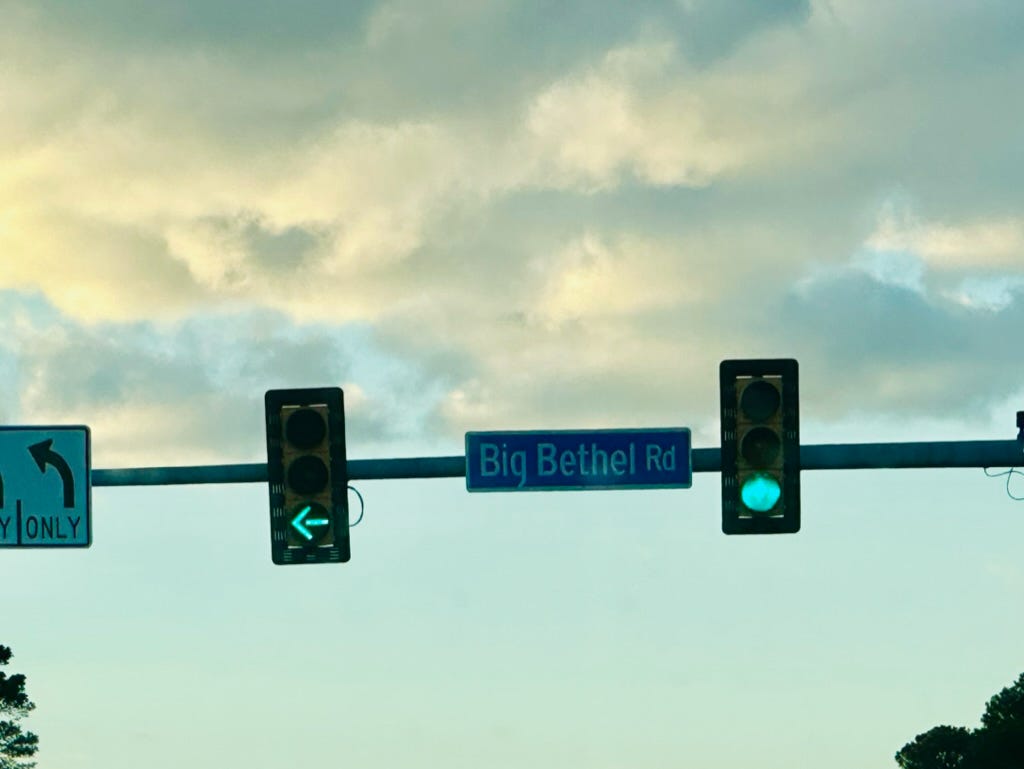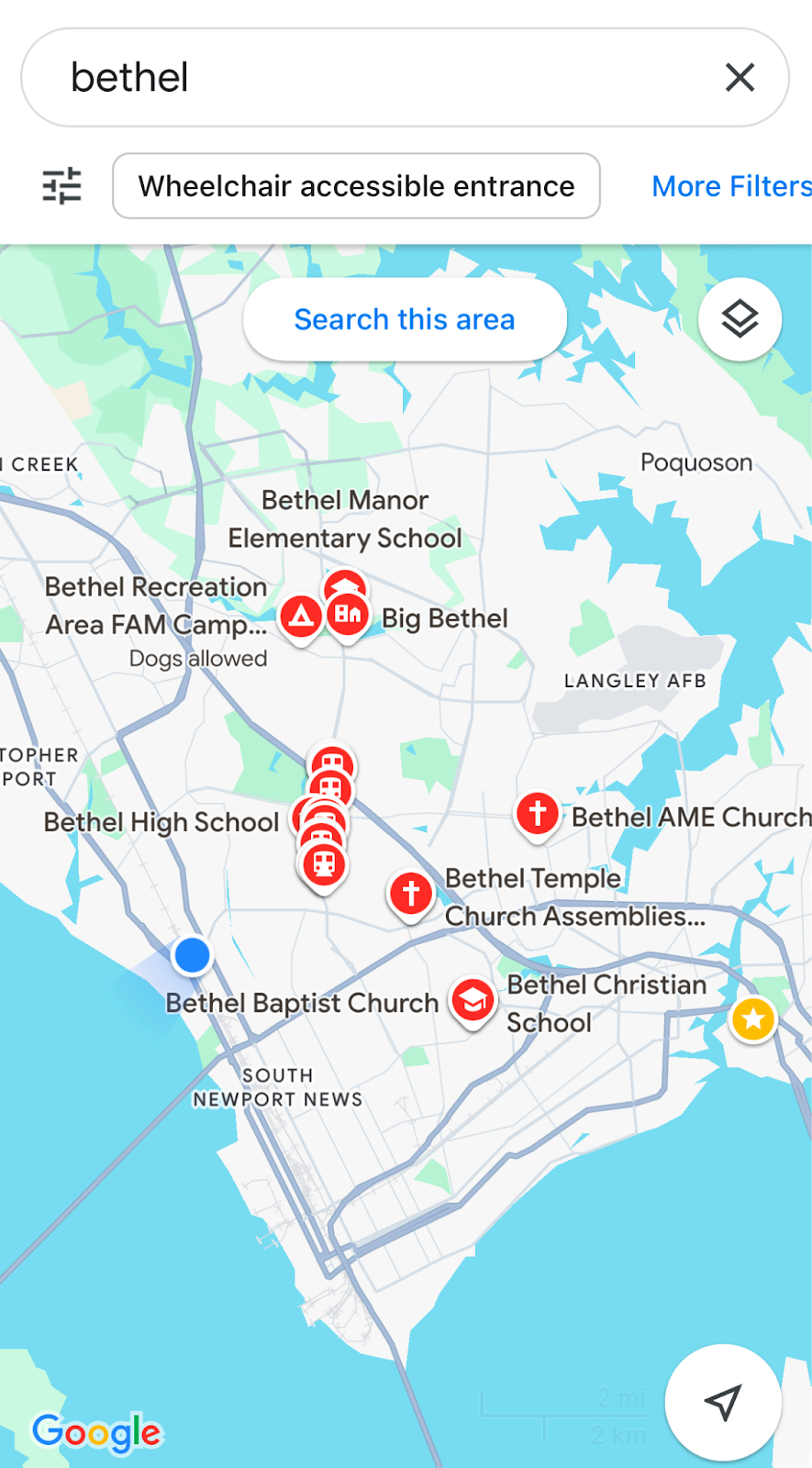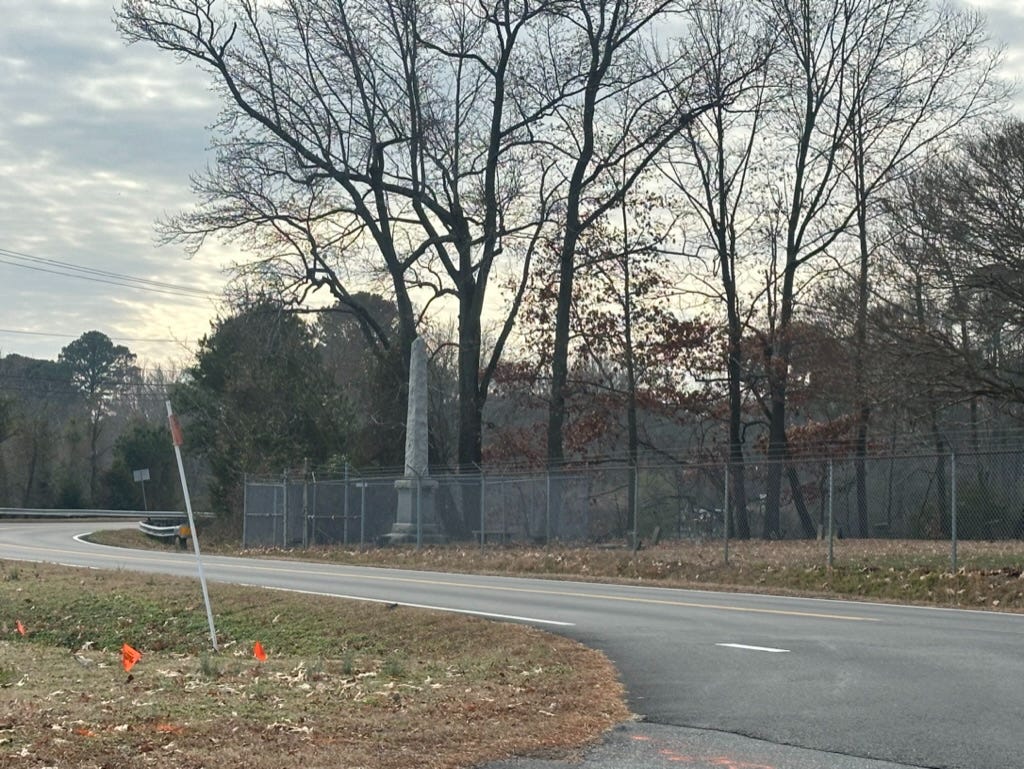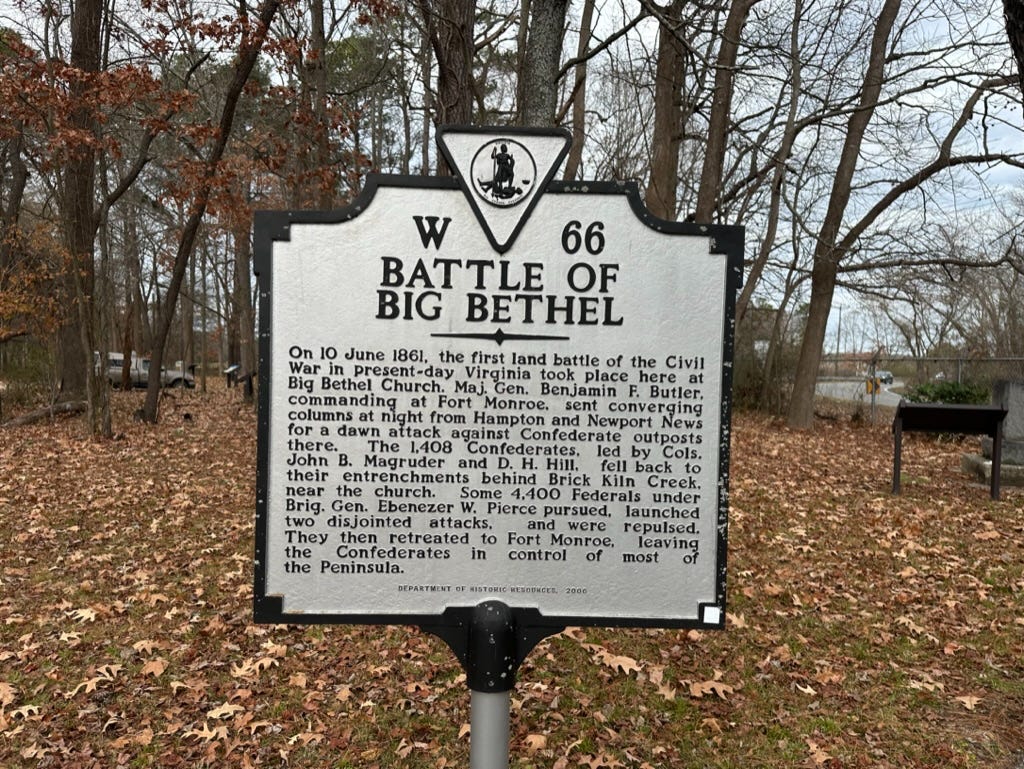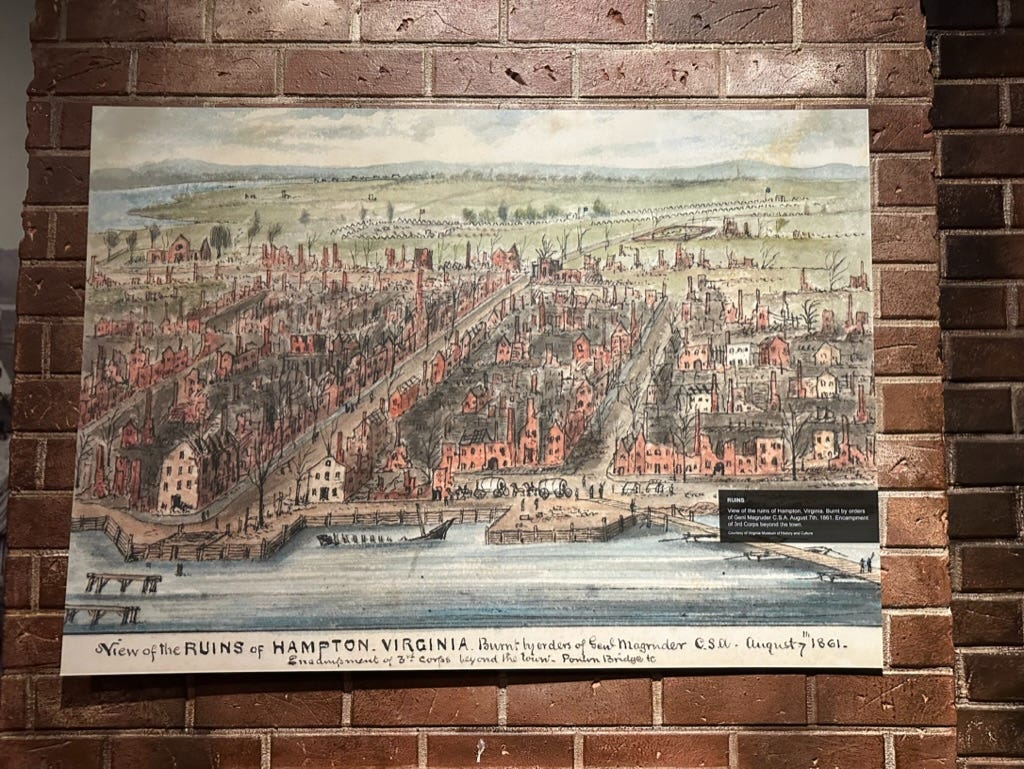“Sanctuaries of peace, plain meeting houses scattered throughout the backcountry of the South, became hallowed landmarks on the battlefields of the Civil War. Big Bethel was the first of these sacred places whose name became synonymous with bloodletting, though with each succeeding campaign the numbers engaged and the ferocity of conflict intensified greatly. The church names of Shiloh, Dunker, and the Wilderness connote slaughter and torn land wrought by immense armies.
—J. Michael Cobb, Edward B. Hicks, and Wythe Holt, Battle of Big Bethel: Crucial Clash in Early Civil War Virginia (2013)
Big Bethel and Me
Growing up in Hampton, Virginia, one becomes very familiar with the name “Bethel.” It’s everywhere: Bethel High School, Big Bethel Road, Bethel Manor. The list goes on and on. And really, the name “Bethel” in Hampton is almost as ubiquitous as the water that surrounds the southern Virginian peninsula us peninsular natives call several different things: The Peninsula, Hampton Roads, Tidewater, The 757, or any other iteration of this place that has cropped up in the twenty years since I moved away.
Street sign for Big Bethel Road, the road along which all of my childhood homes sit.
Bethel High School is a major institution in Hampton and has a loyal Basketball fan following.
My parents’ church that I grew up in and the school I attended from kindergarten to high school
The site of the Battle of Big Bethel is now called Bethel Park.
But Bethel is still big there. A simple map search will serve as an example of what I am trying to get across. Bethel is just everywhere. But why?
There is, of course, a Biblical place called “Bethel.” Or, more accurately “bet’el” or “bayt il.” In Hebrew it is בֵּית אֵל and in Arabic بيت إيل. Both mean “house of God” and are a reference to the Biblical city where the story of Jacob’s ladder is set. And this is where the name comes from originally. In the nineteenth century, many churches took the name “Bethel.” And this is where our story starts. The name of the battle gets its name from a church that used to stand on the site where the battle would take place.
But First, This Substack & Me
Here is what I’m going to be doing with this substack. I am a professor of American literature and a scholar of memory studies. I’m obsessed by memory—my own and how we collectively remember the past and use memory to create pasts that never existed. In short, this substack is going to be about how we collectively use the past—for good and ill.
It’s no wonder I’d go on to study collective and historical memory in the American context. I grew up between three ur-sites of American memory: Jamestown, Yorktown, and Williamsburg. So, I’m starting this substack where I started, in Hampton, Virginia on Big Bethel Road. I was an obsessive child. And not much has changed. I’m still obsessed with these sites and these histories I will walk you through. So, welcome to my obsessions—my manias!
Also, I also travel a lot. So, I’m going to take you on the road with me. Posts will be about the place I am in at the moment or have just been to in the past couple weeks. And stay tuned for smaller notes where I’ll cover events and conferences I speak at or attend.
Back to Bethel Mania
So, let’s do this. Let this memory maniac show you how Bethel mania subsumed my hometown. I grew up going to Bethel Baptist Church. In fact, my father was the pastor of that church. I went to Bethel Christian School. My father helped found Iglesia Bautista Betel. I spent my summers as a teenager working at Igreja Batista Betel in São Paulo, Brazil, an offshoot of my father’s church in Hampton. I spent a lot of time at my best friend’s house at Bethel Manor, a housing complex for people working at the nearby Langley Air Force Base. All of my childhood homes were right off Big Bethel Road on which sits Bethel High School—famous to basketball fans since Allen Iverson attended there. I could go on, but I think you get the idea. My childhood was surrounded and subsumed by this name “Bethel.”
I will get back to Bethel. But beyond Bethel, Hampton, VA is just obsessed by historical memory. Hampton lies on a peninsula that also includes Jamestown, Yorktown, and Williamsburg—the holy trinity of early American and Virginian history. History museums, battlefields, historical reenactments, battle monuments and memorials. These are the bread and butter for a kid growing up in a place like this. Hampton often gets lost in this mix of history. Yet, this, my hometown, is a place obsessed with historical memory. I’ll give you another example:
Many random residential street names in Hampton and Newport News bear these outsized historical names.
Over the holidays while visiting my parents in Hampton, I asked my dad why so many things in Hampton were named “Bethel.” He said that, of course, it was because of the Battle of Big Bethel. I said, “The what?” He went on to explain that just down the road from the house there was a Civil War battle site. I stood there in the kitchen a bit perplexed. I pride myself in knowing quite a bit about my hometown—from the site of the pirate Blackbeard’s execution, to The Emancipation Oak on the campus of Hampton University, to the history of St. John’s Episcopal Church, the oldest English-speaking church in the country. But somehow, one of the first battles of the Civil War had eluded me? In digging and asking around, I found I was not alone. My casual survey of locals led me to the fact that many lifelong residents had never heard of the battle either. How had our collective memory failed us?
The Basics of the Battle
Here are the basics of the battle. If you want to get into the really gritty details of it all, please check out my further reading section below! On June 10, 1861, Union General Benjamin Butler attempted to take the Virginia Peninsula. It was a strategic point as it was where Fort Monroe was (and still is) located. The Union march into the peninsula started off as a carefully planned attack until everything went wrong. Union troops accidentally fired on each other in the darkness just before dawn. This destroyed the element of surprise, and it alerted the Confederates to get ready. Things got messy quickly.
Confederate Colonel John B. Magruder saw this as an opportunity. He set up his troops by the church on what is now Big Bethel Road. The Union forces were now led by General Ebenezer Pierce, who launched uncoordinated attacks against the Confederate positions, which were well defended. The battle was easily won by the Confederates, and the losses of life reflect this. The Union suffered 18 deaths and 53 wounded, while the Confederates saw 1 killed and 7 wounded.
What stands out as really important here is how Big Bethel was a battle of firsts. First, Americans had never been shooting at each other in any large scale way. What emerges from my research here is that many Hamptonians had never really heard gunshots before. This must have been terrifying. Beyond that, the battle, by some accounts, was the first land battle of the Civil War. The Clash at Fort Sumter had occurred just two months before, and Big Run/Manassas would not happen until the next month. It was also one of the first instances of enslaved Black Americans fleeing to the Union side to escape their enslavement. Beyond this, it was a signal to the Union that this war was not going to be easily or quickly won, and it bolstered Confederate confidence in its ability to perhaps win a war most thought was a fait accompli.
The Battlefield Now & Bethel Memory
What exists now of from the battle? Honestly, not much. A manmade reservoir has drowned most of the site. But there are some hints of it. After my conversation with my dad about this massive gap in my own memory of my hometown, I drove the five minutes over to the site. Here is what I saw.
North side of the Bethel Reservoir with sign signaling tourists and researchers are not welcome
Confederate graveyard at the site where Big Bethel Church once stood. The monument was placed there and funded by the Daughters of the Confederacy in 1905.
A historical marker notes the site of the actual battle.
Throughout the site, other markers do a good job of walking visitors through the events of the battle.
What really remains is this name Bethel that is just everywhere. After visiting the site, I still had many more questions. But there was one resource I had overlooked: The Hampton History Museum. On my last day visiting my parents, we stopped at the museum.
The Hampton History Museum exhibit on the battle is not to be missed.
As we walked through the museum, I new I wanted to get to the exhibit on the battle and its aftermath, but there was just so much along that I got distracted with thousands of years of history that happened in my hometown, but I will have to save that history for other weeks! Stay tuned.
Magruder Memory
Growing up in Hampton, there was another name so ubiquitous we thought little of it. Magruder Boulevard ran parallel to Big Bethel Road. We always just said “Magruder”: “Oh, that business is just off Magruder.” Or, “Take Magruder down to the parkway to get to Big Bethel.” You get the idea. In 2020, when nearly 100 Confederate statues came down, many street and place names were changed as well. One of those was Magruder Boulevard. It is now named Neil Armstrong Parkway, a way to memorialize the extensive presence of NASA in the area and the training that happened there for the first astronauts as NASA’s Langley Research Center.
As with the backlash over the name changes and statue topplings of 2020, many thought that Magruder’s name was removed for the fact that he was a Confederate. This is part of the story, and this renaming would be justified if this were the only reason. But, and there is a big but. Magruder burned Hampton to the ground! Seriously! One of Hampton’s major thoroughfares was named for a person that ordered the city burned down. Just after the battle, Magruder ordered the city (my hometown!) burned so that the Union could not take and fortify it.
Exhibit at the Hampton History Museum on Magruder’s burning of Hampton
Extent of the damage after the burning as shown at the Hampton History Museum
As the guide at the Hampton History Museum reminded us, it’s good to name things after people who didn’t burn the city down. Of course, Confederate generals, as a rule, aren’t great inspirations for place names—especially in a city that is 49 percent Black or African American and home to Hampton University, one of the best known HBCUs!
Memory & Mania
I am fully aware that this week was also January 6. I was writing this post while thinking about that day and what it means now in our national consciousness—our collective memory. Like 9/11 or December 7, January 6 is certainly a date that will forever remain in American memory infamy. But already the memory of that day is being repackaged as a love fest by some and a day of warning by others. Yet, we do have a memorial for it. I am always on the lookout for new memorials being built or planned, and this is what we have so far for January 6, a poop-on-a-desk art installation. I am a fan of playful memorials and monuments, but for January 6, this is a misuse of memory. Seriously, is this the best we can do? Next month I will be in DC speaking at a conference. I will stop by to see if the poop is still there.
And here’s my takeaway not only from the Battle of Big Bethel but from any event we try to repackage for certain ends. Collective memory is important, and how it gets delivered and passed down is extremely important at a time where memory gets erased, remade, and repurposed so often. And this is what I’ll be doing with the substack—examining the original event and then how the event mutates and becomes useful to those with and those without power. The real event lies somewhere in the mess of cultural memory, but often the event is quite obscured by its uses and misuses. This is why I am a memory maniac. This is what keeps me up at night.
Coming Next Week: John Adams in Bilbao, Spain!
Stay tuned for next week when I explore how a storm that knocked John Adams’s ship off course on his way to meet Ben Franklin in Paris and why there is now a statue of Adams in the middle of Bilbao, Spain.
And in the coming weeks I’ll cover my trip to Burgos to discover how that city memorializes El Cid, Jimmy Carter’s time at First Baptist Church in D.C., and lots of other memory sites. So, subscribe and stay tuned!
Further Reading & Resources
The Hampton History Museum’s exhibit on the Battle of Big Bethel and the burning of Hampton is a must visit for anyone interested in the history of the Virginia Peninsula. The museum traces the history of Hampton and the surrounding area for thousands of years from its first Indigenous residents through the English occupation of the area and up through today. The staff was extremely helpful in working out some of the details of the Battle of Big Bethel. There is a lot there about pirates too—another obsession of Hampton and a subject I will get to in a later post. They also offer great tips for local dining and touring. It is just a not-to-be-missed place!
There is an essential book for understanding the battle and its importance: Battle of Big Bethel by J. Michael Cobb, Edward B. Hicks, and Wythe Holt
Gerald Prokopowicz interviews J. Michael Cobb about the book on his podcast Civil War Talk Radio
A second excellent book on the battle and its importance to the Civil War is John V. Quarstein’s Big Bethel: The First Battle.
The Williamsburg Yorktown Daily has a great piece on some of the reasons this battle has been forgotten. I felt a little less horrible for not knowing about the battle after reading this.
And the New York Times highlights how the memory of the battle was manufactured by Confederates who used a map of the battle as a memento.





